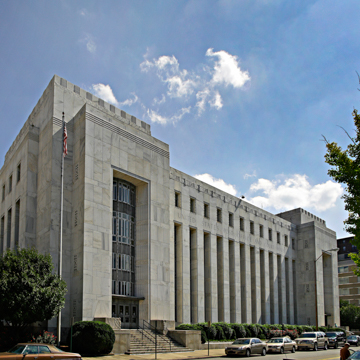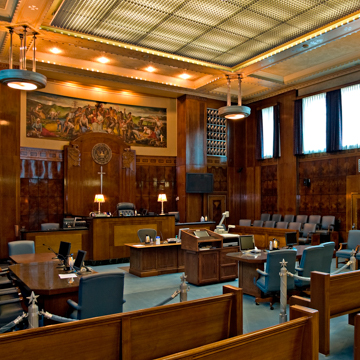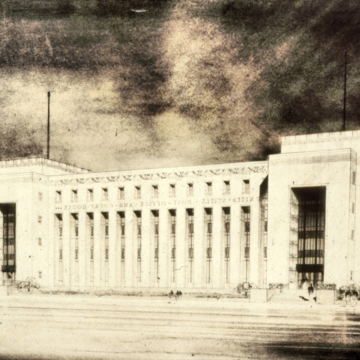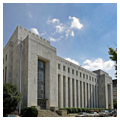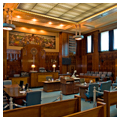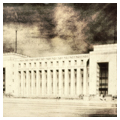You are here
Joel W. Solomon Federal Building
During the Depression, Tennessee received a remarkable level of federal support. Even before Franklin Delano Roosevelt’s New Deal got underway, the Treasury Department funded many architecturally significant post offices and courthouses throughout the state between 1930 and 1933. Among the finest of these projects is the Joel W. Solomon Building in Chattanooga.
The style of the building— “stripped classicism” or “Art Moderne”—is heavily dependent on the work of Paul Cret, the architect of the Folger Shakespeare Library in Washington, D.C. (1928–1932). Cret was also instrumental in the design of the Solomon’s sister building, the U.S. Post Office and Courthouse in Knoxville, likewise begun in 1931. In these projects by Cret and his contemporaries, traditional materials like marble mix with modern materials like concrete and aluminum, while classical details (friezes, pilasters, entablatures) frame the flat roofs and clean lines associated with the International Style.
While Hunt is credited as the building’s chief architect, stylistically it owes much to the firm of Shreve, Lamb and Harmon, designers of the Empire State Building. Much of the interior detailing of the Solomon Building, especially the aluminum ceilings and elevator doors echo the Art Deco motifs found in the Empire State, which was completed just as the Chattanooga building was rising. Further connecting the two buildings is a medallion set into the floor of the courtroom lobby of the Solomon Building that depicts a stepped Art Deco skyscraper supporting the scales of justice. Correspondence between Arthur Loomis Harmon and Louis A. Simon, Supervising Architect of the U.S. Treasury, indicates that Simon was also involved in the design of the Solomon Building, though to what extent is unknown.
The federal government secured a prominent lot for the federal building: behind it is City Hall, designed by Hunt in 1908; in front of it is Miller Plaza, the biggest park in downtown Chattanooga. Erected at a cost of $493,000, the Solomon Building boasts some exceptional materials. The exterior is clad in White Cherokee Georgia marble over a base of Stone Mountain granite. Dark gray St. Laurent marble from southern France is used for the columns in the main lobby and along the base of every floor. A golden-veined Missouri limestone lines the walls of the main lobby. Pink Tennessee “marble” (it is actually limestone) from Knoxville lines the walls of the upper floors, many panels of which are embedded with the fossils of cephalopods. The interior doors are trimmed with Vermont green serpentine. The floors are of terrazzo, poured into chevron patterns.
Patriotic symbolism abounds throughout the building. Granite stone eagles flank the two main entrances on Georgia Street. Between the entrance projections are thirteen large rectangular windows, each cast of aluminum, a material associated with the modern aircraft industry. Over these windows is a frieze of alternating eagles and stars. More stars can be found on the aluminum ceiling of the first floor lobby. The third floor courtroom is among the finest interiors in the city. The walls are lined with myrtle wood panels and a 1937 mural painted by J. Hilton Leech, The Allegory of Chattanooga.
The Solomon Building marked the end of the long career of its chief architect, R. H. Hunt. Active since 1886, Hunt had amassed a catalog of hundreds of churches, office buildings, and campuses stretching from Virginia to Texas. Indeed, in his day, he was perhaps the most prolific architect in the South; in addition to an office in Chattanooga, he also had offices in Dallas, Texas, and Jackson, Mississippi.
In 1938 the American Institute of Architects selected the building as one of the 150 “most representative and distinctive buildings in the United States” constructed since 1918. Unfortunately, Hunt did not live to see his last major building so honored; he died in 1937. Today the Solomon Building continues to serve as a federal courthouse. The post office, once located on the first floor, is abandoned. Major renovations occurred in 1978 and 1990, but the building remains in fragile condition.
References
Butler, Sara A. “Solomon Federal Building.” In Tennessee Encyclopedia of History and Culture. University of Tennessee Press, 2002-2014. Last updated February 28, 2011. http://www.tennesseeencyclopedia.net/entry.php?rec=1224.
Butler, Sara A. “Inventing an Icon: The Chattanooga Post Office and Courthouse in the 1930s.” Arris: Journal of the Southeast Chapter of the Society of Architectural Historians19 (2008): 21-37.
Townsend, Gavin. R. H. Hunt: Master Architect of Chattanooga.Chattanooga, TN: Cornerstones, 2010.
Wilson, Robert Lake. Building Stones of Downtown Chattanooga. Unknown binding, 1979.
“Joel W. Solomon Federal Building and U.S. Courthouse, Chattanooga, TN,” U. S. General Services Administration. Accessed May 5, 2014. http://www.gsa.gov/portal/ext/html/site/hb/category/25431/actionParameter/exploreByBuilding/buildingId/914.
Writing Credits
If SAH Archipedia has been useful to you, please consider supporting it.
SAH Archipedia tells the story of the United States through its buildings, landscapes, and cities. This freely available resource empowers the public with authoritative knowledge that deepens their understanding and appreciation of the built environment. But the Society of Architectural Historians, which created SAH Archipedia with University of Virginia Press, needs your support to maintain the high-caliber research, writing, photography, cartography, editing, design, and programming that make SAH Archipedia a trusted online resource available to all who value the history of place, heritage tourism, and learning.














